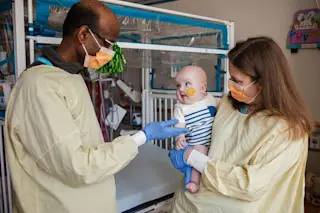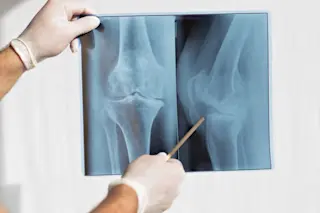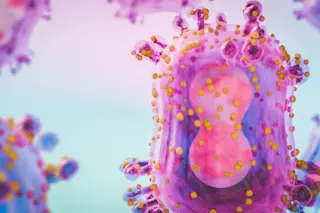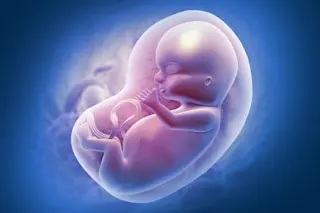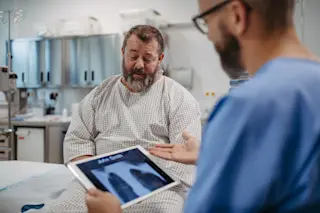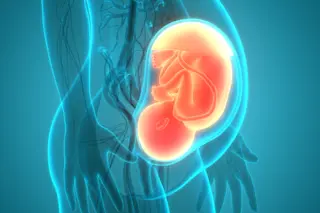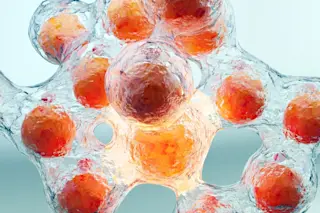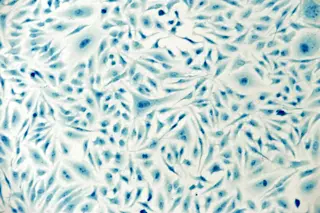I remember the urgency in Andy James’s voice when I got the call for an emergency genetics consultation. I can’t put my finger on it, Bob, but something’s bothering me about this baby, he said. Something’s not right, and I’m not sure what it is. Can you get over here right away?
Coming from Andy, the head of our newborn intensive care unit and one of the best neonatologists I’d ever met, those words meant a lot. But when I saw the baby, just four hours old, lying before me in his Plexiglas isolette, I had trouble seeing what had bothered Andy so. Sure, Edwin Rivera was small: at 4 pounds, 11 ounces, he was a good 2 pounds below the expected weight for a full-term newborn. But there are dozens of causes for low birth weight, only a few of which are ultimately attributable to genetic abnormalities.
I could see that Edwin was breathing without difficulty and that he was moving his arms and legs symmetrically, one side mirroring the other, as it should. His head and facial features were of normal size and shape, and his neck and trunk looked perfect. My subsequent exam pretty much confirmed my initial impression: except for his strikingly small size and enlarged liver and spleen, this baby seemed perfectly normal.
Well, Bob, what do you think? he asked.
I shook my head. I can’t find much wrong, Andy. He is small, and his liver and spleen are enlarged, but that’s about all I can find.
I don’t know how to explain it, Andy said. I just have the feeling that there’s something really wrong with this kid, something that’s not visible at the surface. Have you ever had that feeling about a patient?
Sure, I replied, but, to tell the truth, my Abnormality Detector isn’t picking up any unusual signals around this baby.
I told Andy that the most likely explanation for Edwin’s condition was a congenital infection. There are several microbial and viral pathogens that can infect and damage developing embryos and fetuses. Battling the infection diverts energy and nutrients that the fetus needs to grow, thus causing low birth weight. Moreover, during the battle, red blood cells are destroyed so much faster than usual that the spleen and liver take over the bone marrow’s job of making the cells. Doing that extra work could make those organs grow larger, which would explain Edwin’s enlarged liver and spleen.
The only problem with that idea, said Andy, is that the mother said she wasn’t sick a single day--no vomiting or diarrhea, no fever, no colds, and no rashes.
Andy, in a lot of cases infections that can be devastating to the fetus cause pretty minor symptoms in the mother, I replied.
I know, Bob, but as I said, there’s just something about this baby that makes me uncomfortable. The mother’s lack of symptoms just increases my suspicion.
Well, you’ve had a hell of a lot of experience with newborns, I said, and if you feel there’s something wrong, there probably is. But other than testing for a congenital infection, I can’t think of anything helpful.
We’ll do it, Andy said. Thanks for coming so quickly.
Later, as I was finishing my consultation report on Edwin’s chart, Andy once again approached me. You’re probably going to turn out to be right about an infection, Bob, he said. I just got the baby’s initial blood work back: he’s anemic and his bilirubin is already elevated. I’m going to start him on photo therapy.
Bilirubin is a normal byproduct of red blood cell destruction, and the liver usually produces enzymes that clear it from the bloodstream. But a newborn’s liver, which has just begun working, isn’t as efficient as an adult’s. In most cases, it takes several days for a newborn’s liver to begin making the proteins that break down red blood cells. As a result, most babies pass through a brief period in which the buildup of bilirubin may cause their skin and the whites of their eyes to appear jaundiced, or slightly yellow.
The vast majority of babies handle this transient buildup with no problem. But in babies who have complications such as infections, premature birth, liver damage, or blood types that differ from their mothers, the bilirubin level can rise dangerously high. If too much of it accumulates, the chemical may cross the barrier that separates the blood from the central nervous system. When that happens, it can cause a condition called kernicterus, which can result in permanent brain damage.
The most common and effective treatment for reducing problematic bilirubin levels in newborns is photo therapy. Placing the baby under special fluorescent lights stimulates a chemical reaction that speeds up bilirubin breakdown in the bloodstream.
For Edwin Rivera, the treatment seemed to work. Over the next 24 hours Edwin’s levels of bilirubin stabilized, then declined. No, kernicterus was not going to be a problem.
The next morning, however, Andy called me again. Bob, during the night the Rivera baby developed the weirdest rash I’ve ever seen. He’s got blisters all over his body.
Blisters? I asked. That’s weird. I know babies with congenital infections can have lots of different rashes, but I’ve never heard of blisters. How big are they?
Huge, he replied. And when you rub them, they weep clear fluid. I’ve never seen anything like it before in a newborn.
I told him I’d be right over. But since I’m not very experienced with rashes, I asked if he had called for a dermatologist as well. He said he’d asked Suzanne Comings, one of the hospital’s best dermatologists, to come right away.
I arrived at Edwin’s isolette a few minutes before Suzanne. I stood there gazing down at him. The happy baby I’d seen the day before had been replaced by a crying, miserable wretch, covered from head to toe with blisters the size of quarters. And I didn’t have any idea why.
As I stared at the child, Andy came over. Have you ever seen anything like this?
I had actually seen something similar, in a baby who had a disease called epidermolysis bullosa, or eb, a rare inherited disorder in which the skin forms blisters at sites of trauma. But newborns that suffer from eb are usually born with blisters, and the blisters are restricted to irritated areas.
I was explaining this to Andy when Suzanne entered the nursery. After saying hello, she looked down at the baby and uttered only two words: Oh my. Silently she donned a pair of gloves and, after opening the door of the isolette, she very gingerly began examining Edwin.
Bullae from head to toe, she muttered, adding, Amazing. When did they appear?
Last night, Andy responded. The baby was about eight hours old.
These are bili-lights? she asked, pointing toward the fluorescent bulbs.
We nodded.
When did you start photo therapy?
At about five o’clock yesterday afternoon, Andy replied.
Was that a few hours before the bullae appeared? she asked. Again, Andy nodded. At that point Suzanne peeled back the tapes that held the infant’s diaper in place. The whole area that had been covered, from waist to scrotum, was completely free of bullae. Andy and I turned and looked at each other, our eyes as wide as saucers. Next, very gingerly, using only the tips of her fingers, Suzanne lifted Edwin’s right shoulder off the mattress. We could see that the infant’s back was completely rash- free.
Amazing. Suzanne said, for the second time. Andy, is there someplace dark around here? Someplace that doesn’t get any sunlight?
Andy pointed to a nearby storage closet.
Without hesitation, Suzanne slid her gloved hand below Edwin’s rump and removed his diaper. After stopping at the nurses’ station to grab her bag, she followed Andy into the storage closet, diaper in hand.
As she pulled a small lamp from her bag, Suzanne said, I don’t want to say anything yet, because I’m not sure if I’m right. The distribution of the lesions is unusual--the bullae appear only in areas where the skin has been exposed to light. I know of only one disorder that causes anything like that. Bob, would you close the door?
I pulled the door shut, and the room became pitch black. This is my portable Wood’s lamp, Suzanne said. I’m going to turn it on. Watch closely.
In a matter of seconds, an eerie purplish light began to emanate from the lamp. Simultaneously, the diaper began to emit a bright red glow.
See that? she said. That proves it. This baby has congenital erythropoietic porphyria. Amazing.
Under the ultraviolet rays of the Wood’s lamp, abnormal proteins in Edwin’s urine, called porphyrins, were glowing a fluorescent red.
Congenital erythropoietic porphyria, or as it’s more commonly called, cep, is one of the handful of genetic disorders called porphyrias. What all these disorders have in common are defects in the assembly of hemoglobin, the oxygen-carrying element in our red blood cells. cep is the rarest of porphyrias: it affects a few more than 100 people worldwide. It is also the most difficult to live with.
For individuals affected with cep, the lack of a single enzyme-- uroporphyrin--in every cell of the body has two serious consequences. First, they must rely on blood transfusions to obtain the heme--an essential part of hemoglobin--that their own cells cannot make. Second, the enzyme deficiency prevents them from breaking down toxic protein precursors of heme, called porphyrins. As a result, these proteins build up to extremely high levels in the bloodstream and urine, and when the patients are exposed to any kind of light, the proteins can react in ways that blister the skin. The blisters ultimately heal and form scars. If cep patients are repeatedly exposed to light, their skin becomes heavily scarred and mottled with patches where hair sprouts indiscriminately.
Their sad plight has led some medical historians to speculate that cep may have provided the biological foundation for the centuries-old vampire legend. Consider that cep patients learn early in life that sunlight is harmful and so leave their homes only at night. Moreover, porphyrin deposits on their teeth can produce a reddish color, and excreted porphyrins can darken their urine. In an age when superstition and ignorance ruled, these bizarre symptoms could have given the impression that cep patients had been drinking blood.
After leaving the supply closet, Andy went to Edwin’s isolette and switched off the bili-lights. He then took a clean sheet and covered the isolette’s Plexiglas to block out ambient light.
This explains why he’s so anemic, I said to Suzanne, and I guess the enlargement of his liver and spleen was caused by his body’s attempt to make as many blood cells as possible. But why was he so growth retarded? That doesn’t make sense.
Suzanne shrugged her shoulders. Edwin’s growth retardation didn’t make sense to any of us then, and it still doesn’t. But further testing proved that Suzanne was correct: a test of Edwin’s blood confirmed that he had the enzyme deficiency that causes cep.
For nearly four months, while his family was coming to grips with his problem, Edwin Rivera remained in a darkened corner of the newborn intensive care unit. Within time, his parents learned how to care for him at home, where he now lives in near total darkness.
Today, at age three, Edwin is a healthy and relatively happy toddler whose life is far from easy or ordinary. He ventures out of the family’s apartment to visit friends and family only after nightfall. Because of his severe anemia, Edwin must receive blood transfusions every four to six weeks, which are administered during overnight stays in the pediatric ward at our hospital. Only a bone marrow transplant, which would endow him with normal red blood cells, could free him from his isolation.
Preparations for a transplant are under way, but finding a suitable donor is not easy. Because Edwin has received blood from so many donors, his immune system has produced antibodies to many different kinds of blood. So his immune system would probably reject most donor bone marrow. Thus far, no match has been found, but the hunt for the magic marrow that could rescue Edwin from life in the shadows continues.







